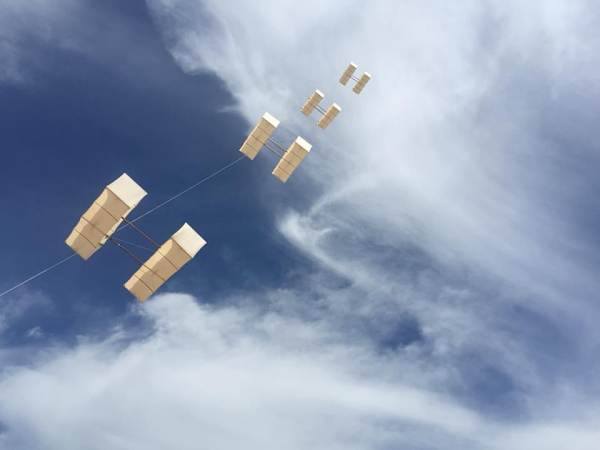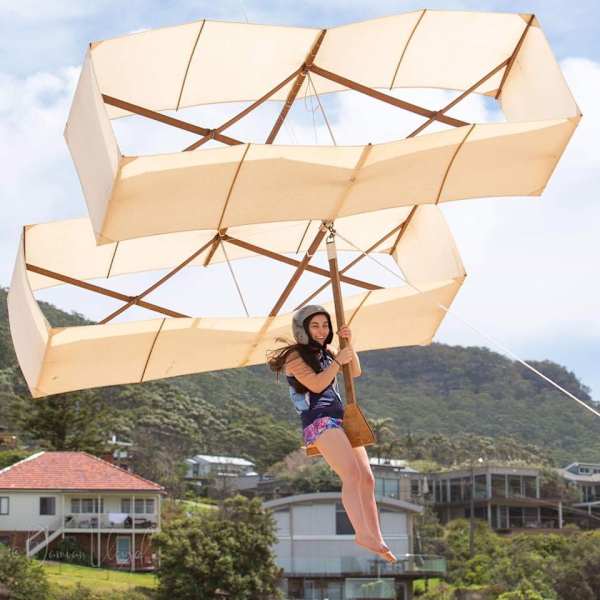By Rob Deacon, president of the Lawrence Hargrave Society
As I sit here on Stanwell Park Beach and watch another massive airliner heading towards Sydney airport to deliver hundreds of passengers from some far-flung place on the planet, I am reminded of the fact that this was not always so. For thousands of years, human flight was just a dream. It took centuries to unlock the secrets of human flight, but one man did probably more than any other person to unlock these secrets and he did much of his work here in Stanwell Park and most famously on this beach. He was Lawrence Hargrave.
The 12th of November 2024 marks the 130th anniversary of the famous Lawrence Hargrave box-kite experiment at Stanwell Park Beach. It was one of the most significant breakthroughs in the development of the flying machine or airplane.
On that day Lawrence Hargrave was raised up 16 feet while tethered to four box kites, which were strung out in a line in the air behind him. It was the first time in human history that a heavier-than-air stable lift-off and landing had been achieved.

Hargrave’s aircraft, the box-kite, was his invention. He had constructed the kites that he flew that day in a workshop that was located on the northern deck of his home, ‘Hillcrest’, at Stanwell Park. Hillcrest still stands today.
The box-kite allowed for stable lift-off, stable flight and stable landing. Prior to the 12th of November 1894, so many experimenters in Europe and America had been experimenting with human flight, often with tragic outcomes, because they could not develop an aircraft that could lift off, fly, and land with stability. Hargrave’s box-kite, therefore, was the great breakthrough. If you look at the first aircraft built and flown by the Wright brothers and Europeans such as Santos-Dumont, you can clearly see that they are a series of box-kites strung together to form an aircraft, which is powered by a rotary engine. Hargrave was rarely credited for his work because he didn’t believe in patents. He shared his ideas freely with the world via journal articles for scientific societies.
The rotary engine was Hargrave’s invention as well. This was the engine that powered aircraft well into the 20th century. There is some dispute about who invented the rotary engine but during a recent visit to the ‘Powerhouse Museum’ at Castle Hill,
I spoke to the curators of the Lawrence Hargrave Collection, and they confirmed it was Hargrave.
He also contributed to the development of the leading thickened wing edge or aerofoil, which can still be seen today on modern aircraft.
These inventions took years of thought, experimentation and development. Hargrave was an amazing man who achieved all of this while living in the relative isolation of Australia at the time, with limited resources to support his dream.
You can see the immense contribution that he made to the development of the early flying machine. When at the Powerhouse Museum, viewing the aircraft engines that he had developed, his kites, gliders, souring machines and his journals, the members of the Lawrence Hargrave Society had a sense that they were surrounded by genius. The copperplate writing, the intricate working of the metal and wood in the engines and gliders revealed a meticulous mind, exquisite craftmanship, determination and resilience.
Hargrave is a great Australian, who we can all be proud of, and he achieved so much of his success while a resident in Stanwell Park. The box-kite experiment of 12 November 1894 is an event of local, national and international significance.
Here, in Hargrave’s words, is a description of what happened on that day as he and his caretaker, James Swain, took the box-kites from ‘Hillcrest’ down to Stanwell Park Beach. “On the 12th a southerly buster came in at 11.00am of what appeared to be the right strength. Swain and I carried five kites and the gear to the beach.”
The kites were laid out on the beach in a line behind Hargrave and in front of him the rope was tied to sandbags that would prevent him from being carried off over Bald Hill.
“Toggled on the sling seat and got onboard with anemometer and clinometer. Swain slacked away the tackle fall to the end. I was then forty two feet from the sand bags and dancing round in an arc of forty two degrees on my toes … after quarter of an hour or so the wind freshened and I went up, wind reaching 18.6mph … the wind fell lighter and I came down. Wind rather puffy, went up several times not long enough to take a wind reading. A long and strong puff then sent me up like a shot and I got a wind reading of 21 mph. Swain read the spring balance 214 lb. Angle of the kite string with the horizontal about 60 degrees, my height above ground, 16 feet. Wind fell lighter and I came down and with purchase just able to haul myself and the kites to the mooring. Swain and I hauled down the kites with some difficulty.”
And with that Hargrave had flown into history.
(Extracts from Lawrence Hargrave-Aviation Pioneer, Inventor and Explorer, W. Hudson Shaw & Olaf Ruhen, University of Queensland Press, 1977.)

Save the date for Hargrave Celebrations
- 12 November On Tuesday 12th at 11am, the Lawrence Hargrave Society will attempt to re-enact the box-kite flight on Stanwell Park Beach using full-sized replicas of the kites that Hargrave used in 1894. Who will be brave enough to take to the air if the wind is strong enough on the day?
- 12 November The Historical Aircraft Restoration Society will stage the ‘Lawrence Hargrave-Eric Waite Memorial Flyover’ at Stanwell Park at 11am on the 12th with three historic aircraft flying.
- 17 November On Sunday 17th Hargrave’s home ‘Hillcrest’ will be open to the public for a Community Celebration from 11am to 3pm. This will include a tour of Hillcrest where you will learn more about Lawrence Hargrave, his life and achievements, enjoy the stunning views of Stanwell Park and perhaps set yourself up for a picnic lunch on the lawns, or buy a sausage sandwich while listening to music from the local musos.






